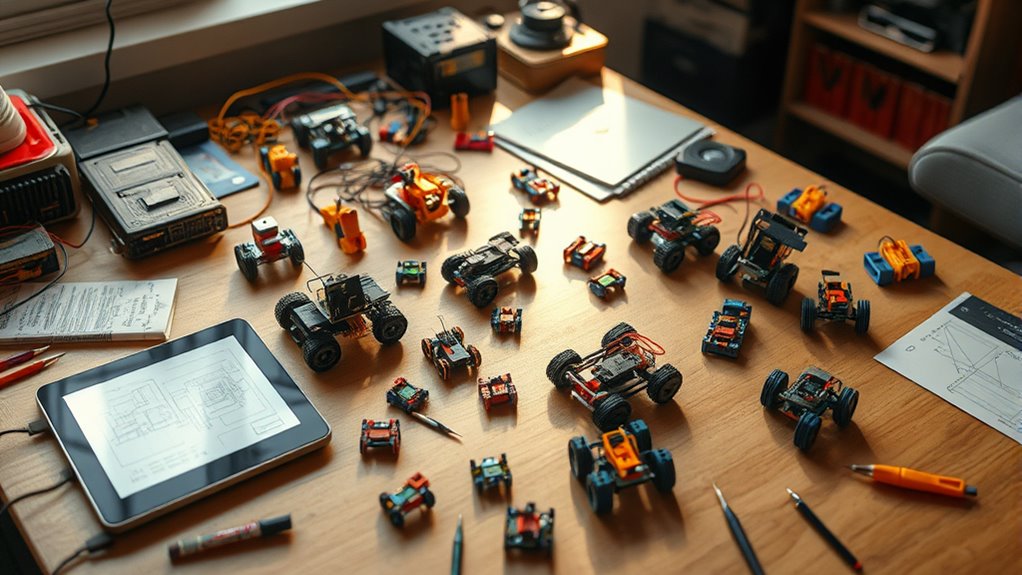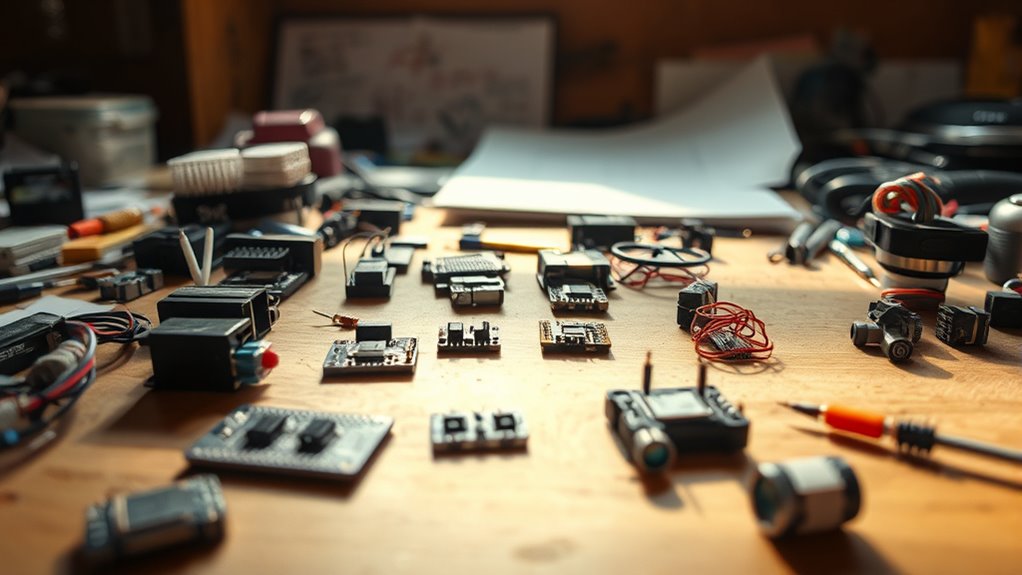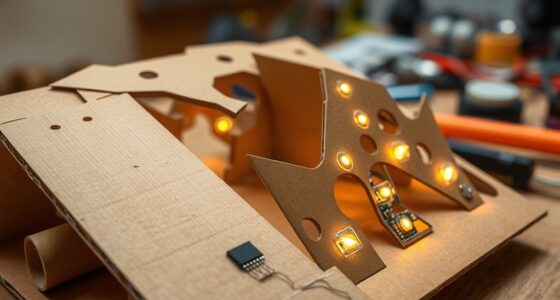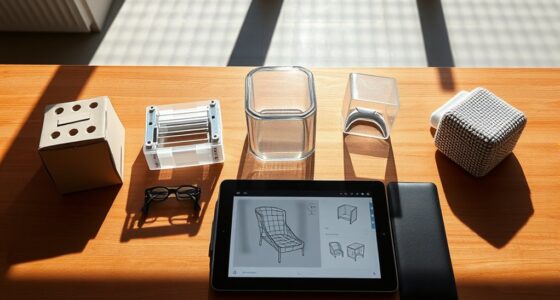A minimum testable prototype focuses on building small, targeted versions of your product to quickly gather insights, validate assumptions, and learn what works. By keeping features simple and essential, you avoid unnecessary complexity and waste. This approach accelerates feedback, helps refine your ideas, and guarantees you’re addressing core needs early on. Embracing these small builds leads to big learning—keep exploring to unseal more effective strategies.
Key Takeaways
- Focus on developing the simplest version that tests core assumptions effectively.
- Small, targeted prototypes enable rapid feedback and iterative improvements.
- Prioritize essential features that directly impact user experience to maximize learning.
- Avoid overbuilding or adding unnecessary features to prevent delays and resource waste.
- Integrate user feedback early to refine the prototype and validate key hypotheses efficiently.
Understanding the Core of Minimum Testable Prototypes

Understanding the core of minimum testable prototypes is essential because it helps you focus on delivering the simplest version of your idea that can still be tested effectively. Your goal is to prioritize core features that directly impact user experience, ensuring you gather meaningful feedback. At the same time, you need to contemplate technical feasibility—building something manageable within your current resources and skills. By stripping down to the essentials, you avoid unnecessary complexity that might obscure insights or delay progress. This approach enables you to identify potential issues early, make quick adjustments, and validate assumptions without over-investing. Ultimately, understanding this core helps you create focused prototypes that are both user-centered and technically practical, laying a strong foundation for future development. Incorporating principles like sound healing science can also inspire innovative approaches to testing and validation.
Benefits of Embracing Small, Focused Builds

Focusing on small, targeted builds offers numerous advantages that can accelerate your development process. When you create minimal prototypes, you gain rapid feedback, allowing you to refine features that truly matter. This approach enhances user experience by quickly addressing pain points and improving usability. Small builds also promote higher user engagement because users see consistent progress and feel their input makes an impact. Additionally, focusing on concise, specific features reduces complexity, making testing and iteration faster. You can identify issues early and pivot without wasting resources. Embracing this method fosters a culture of continuous learning, helping you build more effective, user-centered solutions. Moreover, understanding the relationship dynamics involved in collaborative projects can inform better decision-making during development. Ultimately, small, focused builds keep your development aligned with user needs while streamlining your journey toward a successful product.
Strategies for Rapid and Effective Testing

To test effectively and quickly, focus on your core features first—they’re the foundation of your prototype. Keep your development scope narrow to avoid unnecessary complexity, which speeds up the process. Use iterative cycles to gather feedback early and refine your design continuously. Incorporating AI-powered tools can further streamline testing and development.
Prioritize Core Features
Prioritizing core features is essential for testing your prototype quickly and effectively. Focus on the elements that directly impact user experience and showcase your design aesthetics. By honing in on these features, you avoid wasting time on secondary details that don’t influence the overall perception of your product. This approach allows you to gather meaningful feedback early and make informed decisions about necessary adjustments. Keep the scope narrow to ensure the prototype remains manageable and aligned with your goals. Remember, a well-defined core set of features helps you identify what works and what doesn’t, saving resources and accelerating development. For example, testing a Vetted electric bike conversion kit can provide valuable insights into performance and reliability early in the process. Ultimately, this targeted focus ensures your prototype delivers the most value in minimal time, setting a strong foundation for future iterations.
Limit Development Scope
Limiting the scope of your development efforts guarantees you can test your prototype swiftly and effectively. When you expand your scope too much, you risk feature creep, which complicates testing and delays feedback. To avoid scope creep, focus strictly on essential features that demonstrate your core idea. Resist the temptation to add extras that don’t directly support your test objectives. By narrowing your development scope, you keep the project manageable and ensure quick iterations. This approach helps identify flaws early and gathers meaningful insights without getting bogged down in unnecessary details. Staying disciplined with scope boundaries enables you to learn faster, refine efficiently, and stay aligned with your original goals. Remember, a smaller, focused prototype accelerates learning and reduces wasted effort. Additionally, understanding gear shifting techniques can help optimize your testing process by ensuring smoother rides and clearer insights.
Embrace Iterative Cycles
Embracing iterative cycles means continuously refining your prototype through rapid testing and feedback. You should view each cycle as an opportunity for iterative feedback, allowing you to identify issues early and adapt quickly. By testing often, you enable continuous improvement, making small adjustments that lead to better solutions over time. This approach helps you avoid wasted effort on features or ideas that don’t work, saving time and resources. Keep your prototypes simple, so you can gather meaningful insights without overcomplicating the process. Remember, the goal isn’t perfection but learning. With each cycle, you’ll gain clarity on what works and what doesn’t, accelerating your progress and ensuring your final product aligns with user needs. Introducing silly tantrums and pet antics can add humor and unexpected insights during testing, helping to uncover real user reactions and preferences.
Common Pitfalls and How to Avoid Them

One common mistake is overbuilding your prototype, which can waste time and resources. Ignoring the core needs of your users often leads to solutions that don’t solve the real problem. To avoid these pitfalls, focus on creating the simplest version that addresses the main requirements first.
Overbuilding Risks
Overbuilding your prototype can seem like a safe bet to cover all bases, but it often leads to wasted resources and delays. One major risk is falling into overengineering pitfalls, where you add unnecessary features that don’t address your core problem. This tendency fuels feature creep, making your prototype more complex and harder to test quickly. When you overbuild, you might spend time and money building capabilities that aren’t essential for learning or validation. This distracts from your main goal: testing your assumptions with minimal effort. To avoid this trap, focus on the smallest set of features needed to validate your idea. Keep it lean, test early, and resist the urge to add bells and whistles that aren’t critical at this stage. Additionally, understanding support hours at various entertainment venues can help in planning your testing schedule efficiently—just as knowing operating hours ensures a smooth experience.
Ignoring Core Needs
Ignoring your core needs can derail your testing efforts and lead to wasted resources. When you focus too much on feature distraction, you risk losing sight of what truly matters for your prototype’s success. This often results in scope creep, where additional features or complexity are added without clear purpose, making testing more difficult and less effective. To avoid this pitfall, stay aligned with your core goals and prioritize essential functionalities. Keep your scope narrow and focused on validating the core needs first. Remember, a minimal, well-targeted prototype provides clearer insights and faster learning. By resisting the urge to add unnecessary features, you ensure your testing remains efficient and your resources are used wisely. This approach helps you learn faster and build more targeted solutions. Additionally, understanding the importance of minimal viable product principles can guide you in maintaining focus.
Integrating MTPS Into Your Development Workflow

To effectively incorporate the Minimum Testable Prototype (MTP) into your development workflow, you need to establish clear integration points early in your process. Start by aligning your MTP with your design thinking approach, ensuring it addresses core user needs. Use user feedback from initial tests to refine your prototype quickly, keeping iterations focused and purposeful. Incorporate frequent check-ins where you evaluate the MTP’s performance against user expectations, adjusting your development tasks accordingly. This approach keeps your team aligned and promotes continuous learning. Additionally, considering user engagement strategies can enhance the effectiveness of your prototypes by ensuring they resonate with real user experiences. By embedding MTPs into your workflow, you reduce waste and accelerate validation, making it easier to pivot when necessary. Ultimately, integrating MTPs seamlessly helps you build better solutions faster, grounded in real user insights.
Case Studies Demonstrating Successful Implementation

Real-world examples highlight how successful organizations have effectively implemented Minimum Testable Prototypes to accelerate their development cycles. In these cases, gathering user feedback early allows teams to identify issues and refine features quickly. For instance, a tech startup released a basic prototype to a select group of users, enabling rapid iteration based on their input. Stakeholder engagement was vital, as it kept everyone aligned and provided valuable insights that shaped the product. Another company used small builds to test core assumptions before scaling, saving time and resources. These case studies show that focusing on small, testable versions fosters better communication, improves product-market fit, and accelerates learning, ultimately leading to more successful, user-centered solutions. Additionally, many of these sites are preservation efforts that highlight Alaska’s heritage and offer opportunities for experiential learning.
Frequently Asked Questions
How Do I Determine the Right Scope for My Minimum Testable Prototype?
To determine the right scope for your prototype, focus on scope definition and feature prioritization. Identify the core features that validate your main assumptions and deliver value quickly. Keep it simple, avoiding unnecessary complexity. Ask yourself what essential functions demonstrate your concept’s potential. By narrowing your scope to these key elements, you ensure your prototype is testable, efficient, and provides meaningful insights for future development.
What Tools Are Most Effective for Rapid Prototyping and Testing?
You seek tools that enable quick creation, swift testing, and efficient refinement. You want tools that facilitate rapid prototyping and testing, supporting iterative feedback and design iteration. You need platforms like Figma or Adobe XD for digital interfaces, 3D printers for physical models, and coding environments like Arduino or Raspberry Pi for functional prototypes. These tools help you learn fast, adapt quickly, and improve continuously, making your development process more effective and responsive.
How Can I Involve Users in Early Testing Phases?
To involve users in early testing phases, you should actively seek their feedback during your initial prototypes. Engage them through quick surveys, interviews, or usability sessions, encouraging honest input. Make it easy for users to share their thoughts and observe how they interact with your prototype. This user involvement provides valuable early feedback, helping you identify issues early, refine your design, and ensure the final product better meets user needs.
What Metrics Best Measure the Success of Small Builds?
To measure the success of small builds, focus on metrics like user engagement and iteration speed. User engagement shows how well your build resonates with users, indicating value and usability. Fast iteration speed reflects your ability to quickly test, learn, and improve. Tracking these metrics helps you understand progress, identify issues early, and guarantee your small builds effectively inform future development, leading to better overall results.
How Do I Balance Speed With Thoroughness in Testing?
Balancing speed with thoroughness in testing means you need to incorporate iterative feedback to quickly identify issues without delaying progress. Focus on testing critical features first to mitigate risks early. Use small, frequent tests to gather insights rapidly, allowing you to refine your prototype efficiently. This approach guarantees you stay agile, make informed decisions, and avoid extensive rework, ultimately speeding up development while maintaining quality.
Conclusion
Think of your prototype as a seed—you plant it small, test its growth quickly, and learn what it needs to thrive. Embracing small builds allows you to harvest insights faster, just like a gardener noticing early sprouts. By focusing on your core, you avoid wasted effort and cultivate smarter solutions. Remember, a tiny prototype isn’t just a start; it’s your first step toward bigger, better breakthroughs. Grow confidently, one test at a time.









